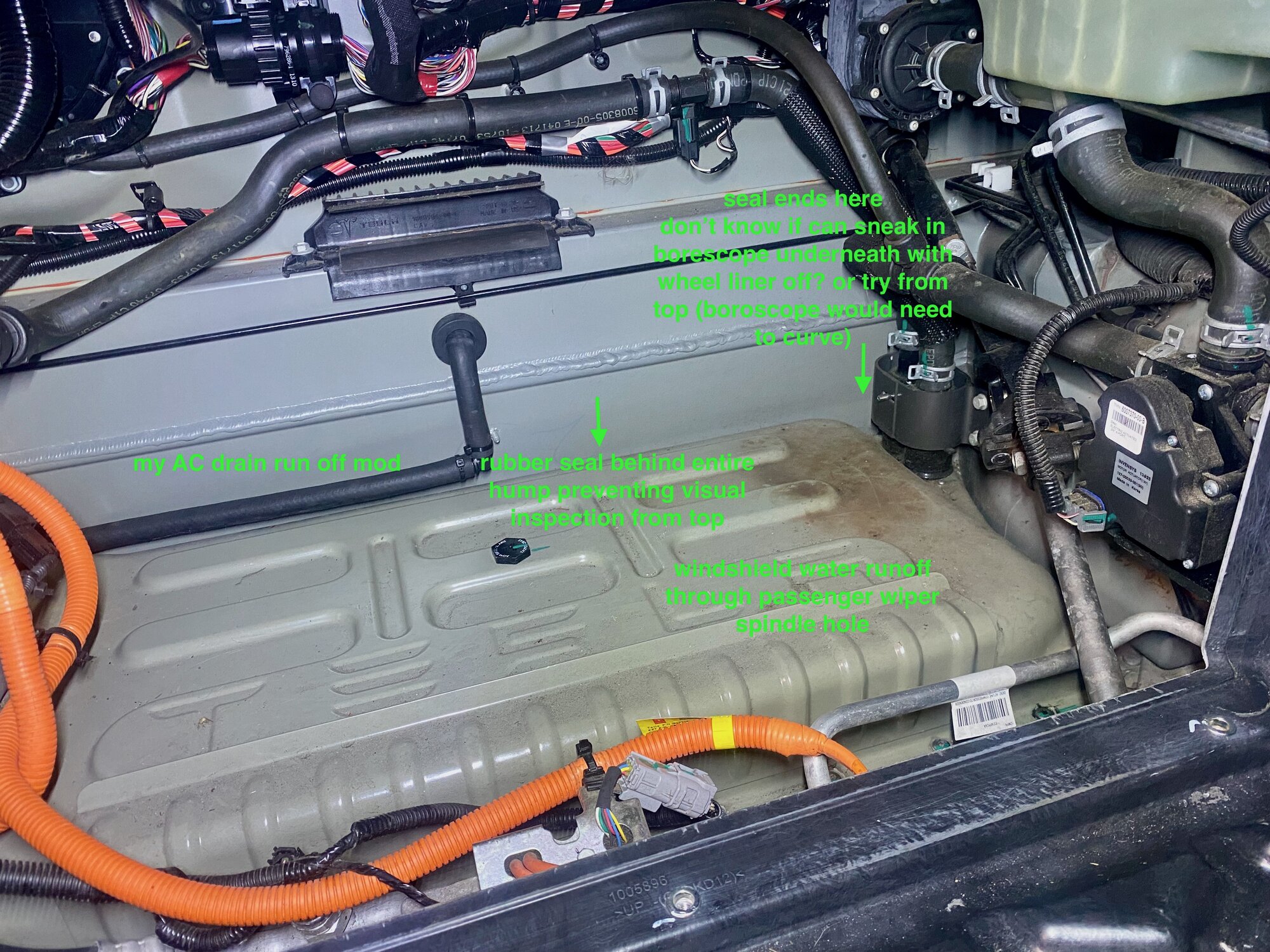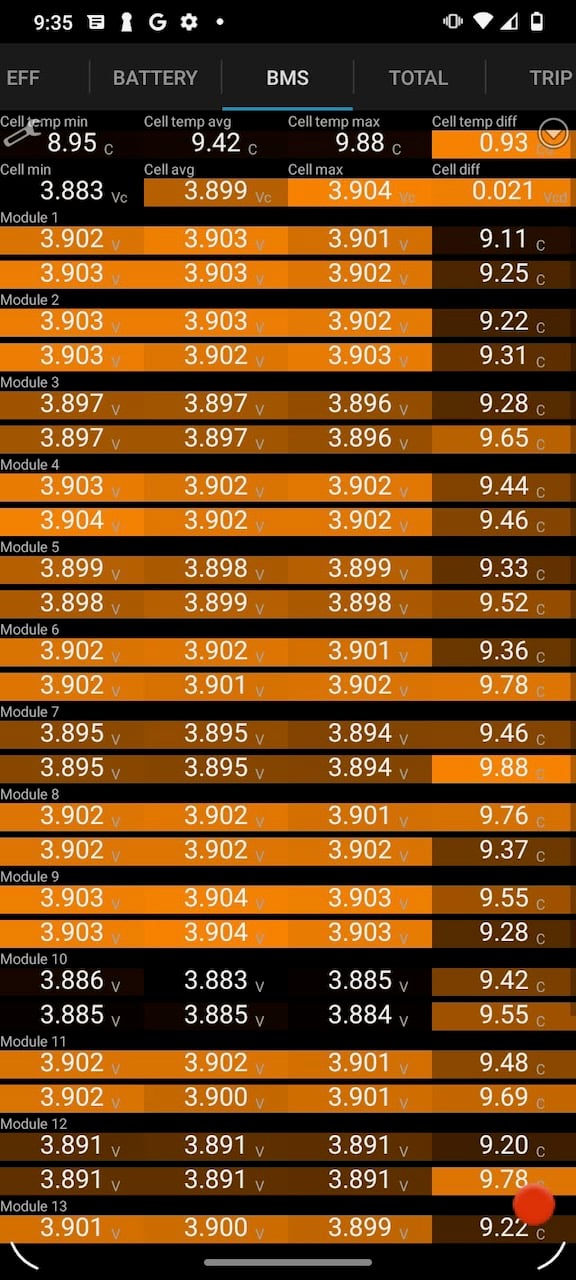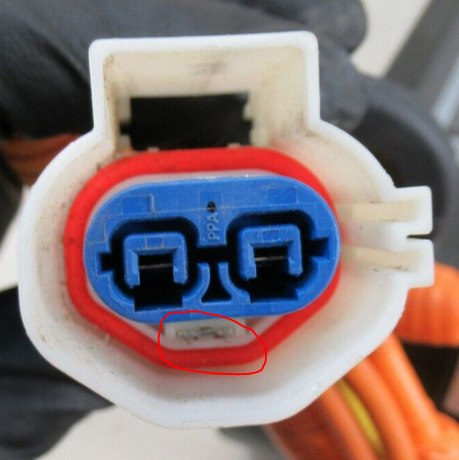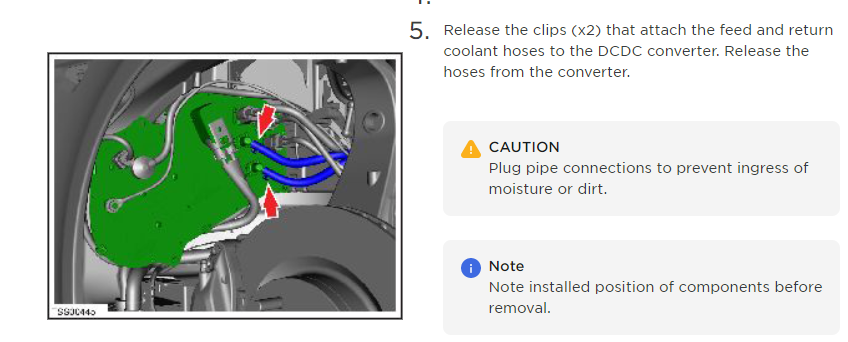Many people struggle with this and it is challenging. Because HV bus is basically shared by all HV devices, 1 device failure disables HV battery output. Some devices are likely not smart enough? (for example the coolant and cabin heater) to report any info to aid car's own diagnostics alerts. Here is a summary of what to consider when chasing this problem.
Deadly HV
First and foremost is recognizing HV is deadly so need to be absolutely aware of all precautions
Most Common HV failures
These seems to be
Check Service Mode and CANBUS
Jump the 12v to backup supply. When HV contactors don't close, 12V will go flat/die quickly with HV battery recharging it.
Inspect service alerts in service mode and CANBUS diagnostic app like ScanMyTesla to see if any noted errors/problems.
Suspecting the HV Battery
Water ingress from fuse cover corrosion is an easy check

 teslamotorsclub.com
teslamotorsclub.com
Check Potential LDU Fault
If have LDU, check speed sensor for wetness and vent hole. If leaking, LDU with vent hole mostly fail with inverter coolant corrosion. LDU without vent hole mostly fail due to soaked stator windings (which inverter senses and prevent HV battery contactors from closing)

Listen for Contactor Noises
This is purely a guess (and I think any Tesla firmware change likely won't change this)
If have fainter contactor noises that repeats, then likely HV battery system is fine but the contactor closing sequence found a fault and stopped proceeding. Also read post #1/#2 for original problem and record video.
13 MS 85 can't go into drive, recent LDU rebuild, some clues from clicking sounds | Tesla Motors Club
Be sure to confirm any contactor noise isn't from inside the HV junction boxes (Pull out rear seat cushion to confirm)
Easier HV Device Failure Test
This requires touching HV system so need to take all deadly HV precautions.
Easiest is probably to unplug, clean and replug coolant heater, cabin heater, AC compressor on Gen1 DCDC cars. For dual motor and Gen2 DCDC, I'm not so familiar but likely a couple of more connectors.
My failure was likely just simple corrosion at these plugs from the challenging high moisture design.

 teslamotorsclub.com
teslamotorsclub.com
If have the dummy KET connectors, can disconnect the 2 heater and AC compressor from the system. Have seen a set for sale before for like $250. Probably rare. In parts catalog but not for sell at Tesla over the counter parts.

 teslamotorsclub.com
teslamotorsclub.com

 teslamotorsclub.com
teslamotorsclub.com
Harder HV Device Failure Test
This requires touching HV system so need to take all deadly HV precautions.
Harder steps require a Magohmmeter (portable meter that injects HV and read resistance) to step by step check each HV client device (motor(s), 2 heaters, AC compressor, HV cabling) Here is Tesla's diag guidelines for gen1 RWD cars. Later gen or dual motor cars will likely have additional steps for the additional motor, junction boxes, HV cabling etc.
====
I think this is roughly the sequence. The actual HV device failure finding involves engaging deadly HV so beware it can kill you.
Info on how to go into service mode, diagnostic tools, and various procedures mostly captured by my Model S website. Basically an organized directory of links back to forum postings for relevant info.
Howards Model S (google.com)
Here is a sample sequence from a member poking at the HV cables and junction boxes to find failure. But he eventually just gave it to Tesla diagnose.

 teslamotorsclub.com
teslamotorsclub.com
Deadly HV
First and foremost is recognizing HV is deadly so need to be absolutely aware of all precautions
Most Common HV failures
These seems to be
- Large Drive Unit (LDU, all RWD and P*D cars <= 2020)
- Coolant heater, cabin heater, AC pump
- HV Battery main contractor themselves
- Water Ingress. Usually front of battery. Fuse cover corrosion seems common.
Check Service Mode and CANBUS
Jump the 12v to backup supply. When HV contactors don't close, 12V will go flat/die quickly with HV battery recharging it.
Inspect service alerts in service mode and CANBUS diagnostic app like ScanMyTesla to see if any noted errors/problems.
Suspecting the HV Battery
Water ingress from fuse cover corrosion is an easy check
Early Model S battery replacements
Hello I’m driving a 2015 Model S 85 with 186k km’s (115k mi). Warranty is about to end in March so I’m interested in the real battery lifetime of the early models, although it’s never a certainty. Would be interesting if there’s some detailed data in a shared spreadsheet to determine average...
Check Potential LDU Fault
If have LDU, check speed sensor for wetness and vent hole. If leaking, LDU with vent hole mostly fail with inverter coolant corrosion. LDU without vent hole mostly fail due to soaked stator windings (which inverter senses and prevent HV battery contactors from closing)
Listen for Contactor Noises
This is purely a guess (and I think any Tesla firmware change likely won't change this)
If have fainter contactor noises that repeats, then likely HV battery system is fine but the contactor closing sequence found a fault and stopped proceeding. Also read post #1/#2 for original problem and record video.
13 MS 85 can't go into drive, recent LDU rebuild, some clues from clicking sounds | Tesla Motors Club
Be sure to confirm any contactor noise isn't from inside the HV junction boxes (Pull out rear seat cushion to confirm)
Easier HV Device Failure Test
This requires touching HV system so need to take all deadly HV precautions.
Easiest is probably to unplug, clean and replug coolant heater, cabin heater, AC compressor on Gen1 DCDC cars. For dual motor and Gen2 DCDC, I'm not so familiar but likely a couple of more connectors.
My failure was likely just simple corrosion at these plugs from the challenging high moisture design.
13 MS 85 can't go into drive, recent LDU rebuild, some clues from clicking sounds
73k miles. Won't go into drive with a bunch of error codes (looks like HV loop disabled). LDU rebuild completed ~ 2weeks ago and driven 350 miles before this problem. Error codes shows repeated attempts to connect HV (presumably to charge 12V and heat battery?) until 12V got too drained and...
If have the dummy KET connectors, can disconnect the 2 heater and AC compressor from the system. Have seen a set for sale before for like $250. Probably rare. In parts catalog but not for sell at Tesla over the counter parts.
Using KET dummy connector on DCDC or jumper HVIL to regain drivability?
One of failures that can disable drivability is some failure modes from the DCDC HV clients (AC comp, coolant heater, cabin heater) These failures don't have much to do with drivability other than coolant heater to enable faster driving+charging. Tesla is being ultra safety conservative @ the...
Using KET dummy connector on DCDC or jumper HVIL to regain drivability?
One of failures that can disable drivability is some failure modes from the DCDC HV clients (AC comp, coolant heater, cabin heater) These failures don't have much to do with drivability other than coolant heater to enable faster driving+charging. Tesla is being ultra safety conservative @ the...
Harder HV Device Failure Test
This requires touching HV system so need to take all deadly HV precautions.
Harder steps require a Magohmmeter (portable meter that injects HV and read resistance) to step by step check each HV client device (motor(s), 2 heaters, AC compressor, HV cabling) Here is Tesla's diag guidelines for gen1 RWD cars. Later gen or dual motor cars will likely have additional steps for the additional motor, junction boxes, HV cabling etc.
====
I think this is roughly the sequence. The actual HV device failure finding involves engaging deadly HV so beware it can kill you.
Info on how to go into service mode, diagnostic tools, and various procedures mostly captured by my Model S website. Basically an organized directory of links back to forum postings for relevant info.
Howards Model S (google.com)
Here is a sample sequence from a member poking at the HV cables and junction boxes to find failure. But he eventually just gave it to Tesla diagnose.
Help Please! 2015 P85D won't drive, isolation faults, replaced battery heater, still dead
Hi all, I'm in need of help. I have a 2015 P85D (March 2015, P69xxx) that has recently gotten the dreaded "Unable to start vehicle – Service is required" error. QUICK TL;DR: iso faults, BMS_f151 & BMS_w142, towed to service who said battery coolant heater, but then it drove, but then errored...
Last edited:


